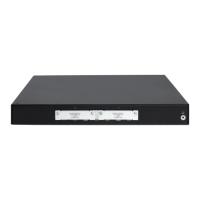243
2. Configure Router B:
# Configure interfaces on Router B to make sure that the local DLSw peer 2.2.2.2 and remote
peer 1.1.1.1 can reach each other. (Details not shown.)
# Configure DLSw on Router B.
<RouterB> system-view
[RouterB] dlsw local 2.2.2.2
[RouterB] dlsw remote 1.1.1.1
# Enable DLSw Ethernet redundancy on interface Ethernet 1/0, and configure the multicast
address as 9999-9999-9999 and set the priority to 10 for primary/secondary router election.
[RouterB] interface ethernet 1/0
[RouterB-Ethernet1/0] dlsw ethernet-backup enable 9999-9999-9999 priority 10
3. Configure Router C:
# Configure interfaces on Router C to make sure that the local DLSw peer 3.3.3.3 and remote
peer 1.1.1.1 can reach each other. (Details not shown.)
# Configure DLSw on Router C.
<RouterC> system-view
[RouterC] dlsw local 3.3.3.3
[RouterC] dlsw remote 1.1.1.1
# Enable DLSw Ethernet redundancy on Ethernet 1/0, and configure the multicast address as
9999-9999-9999 for primary/secondary router election.
[RouterC] interface ethernet 1/0
[RouterC-Ethernet1/0] dlsw ethernet-backup enable 9999-9999-9999
The Ethernet redundancy function will select a router as the primary router. Hewlett Packard
Enterprise recommends that you configure a high-performance router as the primary router by
setting a higher priority for the router.
Ethernet redundancy configuration example for
SDLC-to-LAN DLSw
Network requirements
As shown in Figure 83:
• DLSw operates in SDLC-to-LAN mode.
• Configure DLSw on Router A, Router B, and Router C to connect the IBM host with the SNA
host through the Internet.
• Configure Router B as the primary router and Router C as the secondary router to implement
DLSw Ethernet redundancy.

